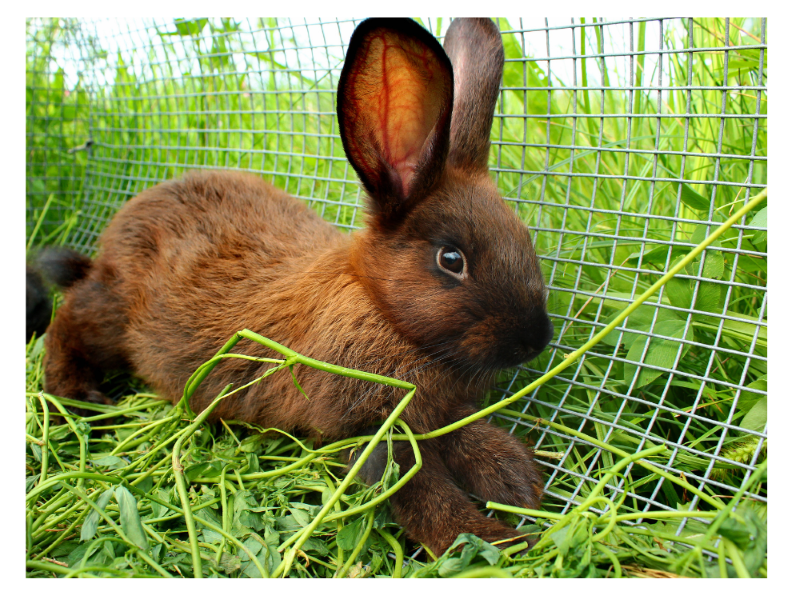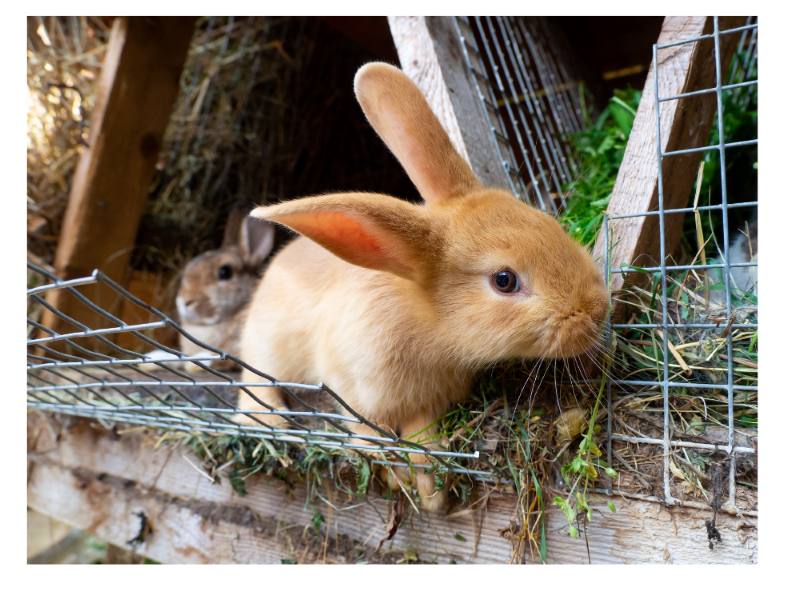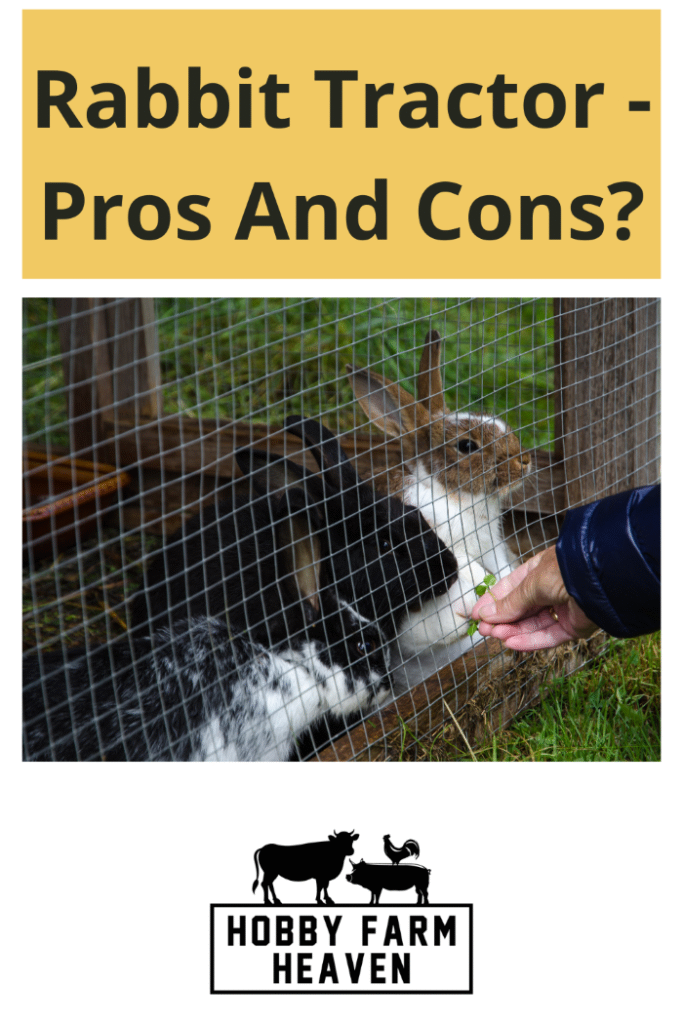Various kinds of animal tractors have been in use on hobby farms and homesteads for many years. They allow owners to easily move animals to fresh ground every day, or twice a day if preferred.
From chicken tractors to duck tractors, to goose tractors…most of the animal tractor applications are for fowl. However, since the 1990’s, Joel Salatin and his son Daniel Salatin have made the rabbit tractor a popular concept in modern hobby farming and homesteading.
What is a Rabbit Tractor?
A Rabbit Tractor is a portable enclosure that allows rabbits access to fresh grasses and herbs in the pasture or on your lawn. You move the rabbit tractor to a new “footprint” every day.
The biggest Rabbit Tractor Pro is that it gets your rabbits onto grass and moving around much more.
The biggest Rabbit Tractor Con is the increased risk of your rabbits catching and spreading parasites such as Coccidiosis.
We have some cool Rabbit Tractor videos below!
What Is A Rabbit Tractor
A “Rabbit Tractor” is a portable enclosure that sits on the ground and allows rabbits to eat fresh pasture, or garden goods, while being protected from the elements and predators.
It is not actually a tractor.
The term tractor has been made popular as the portable enclosure can be systematically moved along between rows of a garden.
The Rabbits eat the grass and weeds and fertilize the garden paths as you move the “tractor” to new ground each day or half day. The Rabbits effectively cultivate the garden as a tractor would.
What Is A Rabbit Tractor For
The Rabbit Tractor is a way to get your rabbits out of a hutch or cage and onto fresh ground each day. As noted, the rabbit tractor can also cultivate and fertilize your gardens and pastures.
How Big Should A Rabbit Tractor Be
Most Rabbit Tractors are made as a three dimensional rectangle, 2 or 3 ft wide, 7 or 8 feet long and 2 or 3 feet tall.
However, some very functional tractors are made as a rectangular prism with an A-frame slanted roof in lieu of a flat or shed style roof. Either way, your rabbit tractor should not crowd your rabbits.
Crowded rabbits are stressed rabbits and stressed rabbits have weaker immune systems and are more susceptible to disease.
.

.
How Many Rabbits In A Rabbit Tractor
The typical 2.5 ft wide by 7 ft long tractor has about 17.5 square feet of floor space, perhaps a bit less if your tractor has an A-frame roof.
If you group your bunnies properly so there is little or no fighting, then you can safely place a mother and her average litter of 7 to 10 offspring in the tractor when the kits are 7 or 8 weeks old.
But as the females mature, they may begin to fight. And as the males mature, they will begin to mount the females. So we recommend separating bucks and does.
All un-neutered rabbits can stay in the tractor from about 7 weeks to about 12 or 14 weeks. But if your bunnies are neutered, then you can keep them in tractors regardless of age.
Rabbit Tractor Pros And Cons
Here we discuss the pros and cons, or good and bad, about rabbit tractors as alternative housing solutions for your rabbits.
The tractors do require your attention and diligence. They are not a short cut for you and they do not make your responsibilities less or easier, however, we believe they do improve the quality of life for our rabbits.
Here’s a high-level breakdown of Pros and Cons.
Rabbit Tractor Pros – Why Is A Rabbit Tractor Beneficial?
- Fresh air and sun
- Rabbits can actually move, hop and run resulting in better muscle tone and physical systems (as in digestive) performance
- Tractor can include an off the ground “hide-away” section
- Food (hay and pellets) can be in the “hide-away” while green grass and water are on the ground – promoting more movement
- These first 4 items go a long way towards happier, less stressed rabbits
- Cultivate and fertilize your garden, pasture, lawn
- Little to no cleanup, as opposed sheltered cage or hutch
Rabbit Tractor Cons – Downside of Rabbit Tractors?
- Not good for wet, soggy, muddy ground
- Regulating temperature may be harder than in the shaded cage or hutch
- Not good in snow
- Diligence is required – Rabbits more likely to get parasites such as Coccidiosis when on the ground
- Need to separate bucks and does
- Not protected from large predators such as coyotes or wolves (perimeter fence required).
- Maintenance of the tractors (wood & fasteners) over time.

Coccidiosis In Rabbits
One of the most common, and most contagious, bacterial diseases in rabbits is coccidiosis.
Coccidiosis is caused by protozoa, single cell, parasites infecting the liver or digestive tract of rabbits. It is found basically everywhere in the soil and has a life-cylce of about 4 to 14 days. And the eggs of the nasty protozoa are in rabbit poop.
- Symptoms – animals are anorexic, lethargic and have diarrhea.
- Affects rabbits at any age.
- Symptoms – animals have a watery, foul smelling diarrhea, weight loss and dehydration.
- More likely to affect younger rabbits from age 6 weeks to 5 months. Newly weaned rabbits are at highest risk.
Strong immune systems and genetics are the best defense against coccidiosis. Meaning find and start with rabbits that have been bred to be strong and then keep those rabbits healthy and strong.
As always, when rabbits or any animals, live in close proximity to each other hygiene is paramount. Needless to say, if using a rabbit tractor you may be at higher risk for coccidiosis.
Coccidiosis Treatment For Rabbits
Treatment of coccidiosis is a tough path. Treatment using sulpha based drugs may help for a while but relapse happens often. Please coordinate with your local veterinarian.
Even if treating your rabbits is not the option you choose, you still need to thoroughly clean and disinfect their environment to include cages, hutches, all waterers and feeders.
A solution of bleach or vinegar may be used for disenfecting.
Prevention for Coccidiosis For Rabbits
On the prevention front we have the following advice:
- If pasturing rabbits, then move them to new ground often; Ground that has not had other livestock or pets on it.
- Feeding twigs that are high in tannin, including oak and willow, ais said to help prevent coccidiosis.
- Add Apple Cider Vinegar to rabbit water at 1 tablespoon for each 32 oz of water
Strong immune systems will typically beat coccidiosis. This is why the illness is most prevalent in younger rabbits whose immune systems are not yet robust.
How To Make a Rabbit Tractor
Your next question may be, “How Do I Make A Rabbit Tractor?”
We have some help for you in the form of some great videos. Meet Daniel @ Mossy Bottom Farm in Ireland! He Builds A Rabbit Tractor!
.
Building a Small Rabbit Tractor & Discussion about Coccidiosis and RHDV2.
.
Video about Making Your Rabbit Housing Decision: Cages, Colonies, and Tractors
.
Frequently Asked Questions Related To Rabbit Tractors
Rabbit Tractor Floor?
It is safest to have a wire mesh floor on the rabbit tractor. With a 2” x 4” wire mesh floor fastened to the bottom framing of the rabbit tractor, you keep your rabbits from digging out and you keep potential predators from digging in to the Rabbit Tractor.
How to Build a Rabbit Tractor?
There are many articles and YouTube tutorials on this topic as the techinques are better watched than read! We’ve linked to several in this article.
Chicken Tractor for Rabbits?
Yes, you can use or modify a chicken tractor for your rabbits. You’ll have to consider the floor (rabbits dig) if you want to up-cycle your used chicken tractor for rabbits.
Final Thoughts on Rabbit Tractor Pros And Cons
Rabbit tractors help get your rabbits out of cages and hutches and onto some fresh grass where they can jump and run. In our opinion, they do provide a better way of life for our bunnies!
But be aware of some of the cons, such as coccidiosis in rabbits.
And always remember: rabbit tractors do not reduce your responsibilities or required diligence as a rabbit owner.
If you have any other questions or want to share your experience with a rabbit tractor, leave a comment below, we would love to hear from you!

